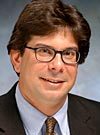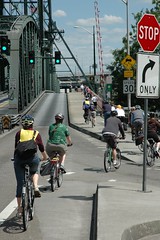
Steve Hymon.
One of the reasons some Portlanders take our bike policies so seriously and passionately (and are not shy about defending them) is because we realize that the microscope is on us. Portland is an important model that many other large cities look to (with even more urgency these days) when they want to learn how to manage, create, and foster a more bike-friendly urban environment.
The choices we make about bike planning here, reverberate far beyond the Portland city limits.
Earlier this week I shared a video about our bike parking facilities and policies that was shot by a film crew from New York City. And yesterday, a traffic and transportation columnist with The Los Angeles Times has published a story on his “Bottleneck Blog” titled, What can Portland teach Los Angeles about transportation?.
I always find it interesting to hear what visitors think about our bikeways, especially when its an expert pundit from a major city like Los Angeles. It’s also worth noting that while we’re impatiently clamoring for better conditions, people from most other major U.S. cities think Portland is bike nirvana.
Here are a few observations about biking in Portland from The LA Times’ “Road Sage” Steve Hymon (emphasis mine):
“…Portland transportation officials say that their own surveys show that actually 6% of the city’s residents are pedaling to work — tops in the nation for a large city.
I’d be skeptical of that number ordinarily. But on a Monday afternoon I sat on my rental bike watching the number of bike commuters heading out of downtown on the Hawthorne Bridge at rush hour. It was one bike after another on the bike lane on the bridge. Upon reaching the east side of the bridge, some cyclists used a special bike exit ramp to reach a bike path running along the Willamette. Amazing.”
The traffic on the Hawthorne these days makes it seem like our mode split is way beyond 6%!
“The funny thing about Portland is that the area really doesn’t have a tremendous number of miles of separated bike paths. Instead, the city has put bike lanes and routes on streets with lower volumes of traffic and emphasized connections.”
That’s an astute observation from a visitor, although I’ve heard recently that PDOT does have some interest in physically separated bike lanes (a.k.a. cycletracks).
“… I rented a bike on the northwest side of Portland. The city’s bike map helped me easily navigate to the riverfront bike path to the Hawthorne Bridge, which has bike lanes on both sides of it.
When a cyclist arrives at the east side of the Willamette River, the bike lane within several blocks peels off busy Hawthorne and instead puts cyclists on parallel residential streets. Again, there were plenty of signs and street markings. And, again, there were a ton of cyclists on the street going both directions..”
It’s nice to hear that a visitor was able to find their way from outside the tourist comfort zone of the riverfront. I talked about this with a USA Today travel reporter a few days ago (here’s the story she wrote) and I wasn’t sure if it would be a good idea to recommend that tourists venture out beyond the Esplanade.
“The funny thing is that many cities here have designated bike routes — you see those little green signs everywhere in Pasadena, for example. I think the difference in Portland is the emphasis on connectivity. It’s also a geographical and cultural thing. Commutes are shorter and residents clearly are into cycling.”
I like how Mr. Hymon seems to understand that such an important part of the bike momentum here in Portland is a “cultural thing.
“Cheryl Kuck, a spokesperson for the city’s transportation bureau, said that as more people have taken to biking, the city is mandated to keep spending money to keep improving facilities.
“If we have users at 4% to 6% or beyond [of all commuters], our capital budget has to create funds for that user group,” she said.”
Well, that would be great if it was actually true. There is no policy that mandates capital spending to be commensurate with mode split. It’s an idea that has come up before, but unfortunately it’s just an idea at this point.
— Check out more of Hymon’s observations (which include thoughts on our Light Rail, parking, Streetcar, and more) on his blog.


